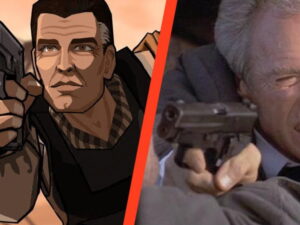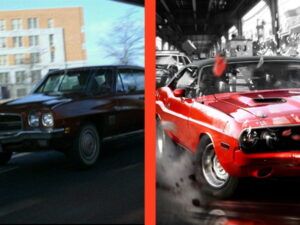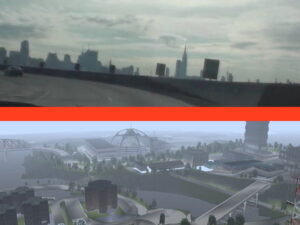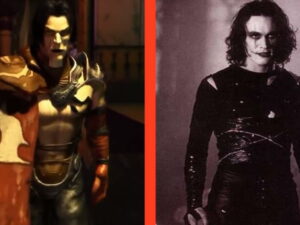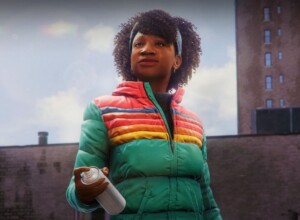Cut Scenes is Josh Wise’s regular column on the intersection between films and video games. This week, it’s Resident Evil 4 vs. Assault on Precinct 13.
Given the lineage of horror classics that have glimpsed their distorted reflections in the hallowed halls of the Spencer Mansion, or the Racoon City Police Department, there’s plenty of low-hanging fruit to pluck down – and plucked down they are. But in the Resident Evil series, there are some scenes and ideas that draw water up from wells a little farther afield.
Beyond the twig-and-twine talismans dangling in the swamps outside the Baker Estate, triggering twinges of The Blair Witch Project; beyond the gently swaying porch swing, nodding back-and-forth to The Evil Dead and The Texas Chainsaw Massacre; or the plush red carpets and thick oak doors of the first game, its grand foyer and split staircase mirroring The Shining.
Resident Evil 4 made sparing and effective use something that prior entries hadn’t: the action set piece. During the second act, you alight at a ramshackle old farmhouse seeking refuge from a torch-and-pitchfork mob. It isn’t horror that rules the day here; it’s suspense, and if it’s that you’re after there’s only one place you need look.
There is an almost languorous fug of tension in Assault on Precinct 13, John Carpenter’s seminal ’70s siege thriller. The air is thick with it. And as we watch, there is the spine-tingling feeling of calm before the storm. Carpenter begins his simmer with the demarcation of the battleground: look at the foreboding twilight behind the Anderson precinct.

Resident Evil 4 cranks up the electrictricity by putting you in control before the storm starts. In this eerie inertia, you need to make preparations for a nerve-shredding siege. There’s a smattering of visual cues telegraphing the odds – check out 0:17 in the Resi 4 clip to see a nice symmetry with this exterior shot (if you catch it just right, you can see the background lit up with lightning, exposing the gnarled treeline in the distance – beautiful!). Jump to 1:09 for an ominous view through the wooden slats – a handy stand in for when Bishop and Louise peer through the venetian blinds in the station.

There was some ground work laid early on in the making of this sequence: Leon has established himself in the mould of Bishop, the calm driving force in the face of overwhelming odds; Luis Sera fills in for the aloof, mysterious Napoleon Wilson, absent yet aware, capable, and with a moral code cutting the fog of his past; Ashley sadly doesn’t fit role of Leigh, scrapping the latter’s cool composure and steady aim for the wherewithal to find a decent hiding spot.
The lack of a tangible time limit is the genius of the scene. You just know that you’d better hurry.
Through the game’s context-sensitive prompts, you set about mechanically – tipping wardrobes over to cover up exposed windows, heaving chests-of-drawers to block off doors. It’s here that one of the game’s most ingenious devices comes into play: the inventory management – often the cause of tension in the quiet moments between encounters – acts like a stopper, prolonging the inevitable and wringing added anticipation for what lies ahead. Now is the time to sort out your ammo, to arrange your guns where you need them, and ensure you have the herbs and sprays you will need.
The action begins in staccato, foregoing rapturous payoff for a sustained bombardment – keeping the nerves jangling, and the mind focused and fretful. Check out 0:30 in the Assault on Precinct 13 clip – it matches up cannily to 3:40 in Resi 4 clip: a shotgun blast through the exposed window stops a would-be entrant, sending them flying backward into the darkness.
The intermittent inventory checking you’ll need in the Resident Evil 4 siege is a signature flourish mirrored in AoP13 in which, after a vanquished wave, Bishop, Wilson, Leigh, and Wells all call out to one another the number of remaining rounds they have.
It’s worth noting that an homage to Assault on Precinct 13 is by its very nature paying homage to two additional films: Rio Bravo (Carpenter tipped his hat to Howard Hawks throughout his career) and George A. Romero’s prototypical zombie film Night of the Living Dead. Don’t let the subject matter fool you, though; the suspense and the meticulous construction of the scene ground Resident Evil 4’s roots more so with Carpenter’s work than it does Romero’s.



